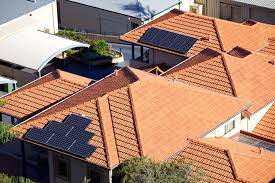A tidal wave of storage deployment will be very soon upon us. It is likely that the largest take-up of storage will be small scale or ‘incremental’ storage within the suburbs, mirroring solar uptake.
The concept of taking a suburb “off-grid” is not as far-fetched as it sounds, given that single households are already doing it. The possibility of making a collection of houses self-sufficient in electricity by creating energy “clouds” can now be achieved at or below the cost of standard poles and wires and, once the generation capacity is credited back, it becomes cheaper still.
For example, let’s build a subdivision with 3000 dwellings, 2000 single houses, 500 townhouses and 500 medium rise units. Based on distributor data, the maximum demand for these dwellings would total 9.5 megawatts, with a daily average consumption of 54 megawatt hours per day.
Through diversity many of these dwellings will share common peaks, however many will not require power at these times. Of the 3000 dwellings, 2500 are immediately available to fit solar PV, if each single dwelling were built to accommodate 6 kilowatts of solar and each townhouse 4 kilowatts, we can conceivably produce 54 megawatts of electricity per day.
In order to provide for 9.5 megawatts of peak demand, presumably at night, 20-30 megawatt hours of storage needs to be available. This storage need not be only deployed at the solar sites; if we install 10KWH in each of 3000 dwellings we have 30MWH of storage, enough to cover demands of all residents.
Now, based on a simple import export tariff structure, a capital expense of say $24 million and an average 20% R.O.I., the average cost per kilowatt of electricity needs to be 24 cents. The capital contribution by a broad-acre developer for distributor head-works can be as much as $6000 per dwelling, but creating an interconnecting web rather than a hub and spoke network can halve these costs, a possible $10 million saving over a project. This permits the installation of small distributed stand-by generators, say 10 @ 500KVA, allowing for 5MW of emergency top-up in the event of seasonal peaks of prolonged bad weather.
In the case of bad weather, especially in sub-tropical climates, the reduction in electricity demand and use is proportionate to the severity of bad weather. Effective load management through 5 minute TOU tariffs should tackle a situation of energy starvation in even cold climates. What must be considered before one dismisses this scenario is the levelling effect of the installed storage and how, even in the worst of solar days, energy is still being produced. If we add to our new suburb a shopping centre of say 1 hectare, with 10 megawatts of solar and say 5 megawatts of storage, we again have strengthened the reliability of our electricity cloud.
And we are not talking about significant capital expenses compared to the current model.
Are there any developers out there who want a go at this??










